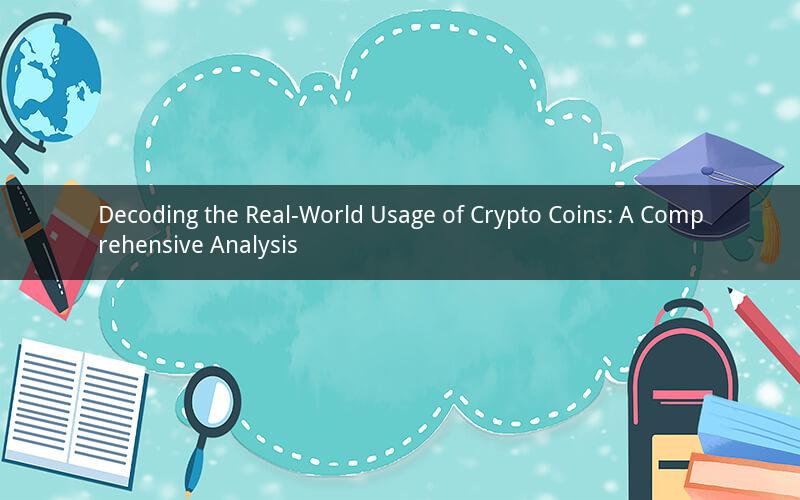
Introduction:
The world of cryptocurrency is vast and diverse, with numerous coins being introduced every year. However, not all crypto coins have gained widespread adoption or real-world usage. In this article, we will delve into the world of cryptocurrencies and identify which coins are actually being used in everyday life. By examining their real-world applications, we can gain a better understanding of their relevance and potential for long-term success.
1. Bitcoin (BTC)
Bitcoin, the pioneer of the cryptocurrency revolution, remains the most widely recognized and used crypto coin. Its decentralized nature and limited supply have made it a preferred choice for transactions, investment, and as a store of value. Bitcoin is accepted by various online and offline businesses, making it a practical choice for real-world usage.
2. Ethereum (ETH)
Ethereum is the second-largest cryptocurrency by market capitalization and has gained significant traction in the real world. Its smart contract functionality has enabled the creation of decentralized applications (DApps) and decentralized finance (DeFi) platforms, revolutionizing various industries. Ethereum is widely used for transactions, investments, and the development of innovative projects.
3. Litecoin (LTC)
Litecoin, often referred to as "silver to Bitcoin's gold," is another popular crypto coin with real-world usage. It offers faster transaction confirmation times and lower fees compared to Bitcoin. Litecoin is accepted by several online and offline merchants, making it a convenient option for daily transactions.
4. Ripple (XRP)
Ripple is a unique cryptocurrency designed to facilitate cross-border payments and financial transactions. Its underlying technology, RippleNet, has been adopted by various financial institutions and payment processors worldwide. Ripple is widely used for international remittances, making it a practical solution for real-world applications.
5. Binance Coin (BNB)
Binance Coin, the native token of the Binance exchange, has gained significant traction in the real world. It is used for various purposes, including trading fees on the Binance platform, purchasing digital goods, and participating in governance. Binance Coin has also been integrated into several other platforms, expanding its real-world usage.
6. Cardano (ADA)
Cardano is a blockchain platform that aims to provide a more secure, transparent, and sustainable infrastructure for decentralized applications. Its real-world usage is growing, with several projects and DApps being developed on the Cardano network. Cardano is also used for payments, investments, and the creation of new tokens.
7. Polkadot (DOT)
Polkadot is a protocol that aims to enable different blockchains to connect and share resources. Its real-world usage is expanding, with various projects and DApps being built on the Polkadot network. Polkadot is also used for cross-chain transactions, making it a valuable asset for real-world applications.
8. Chainlink (LINK)
Chainlink is a decentralized oracle network that provides real-world data to smart contracts on blockchain platforms. Its real-world usage is increasing, with several projects leveraging Chainlink's data services for various applications. Chainlink is widely used for insurance, supply chain, and financial services.
9. Stellar (XLM)
Stellar is a payment network designed to facilitate cross-border transactions and enable financial inclusion. It is widely used for international remittances, making it a practical solution for real-world applications. Stellar's low transaction fees and fast confirmation times have contributed to its growing adoption.
10. Dogecoin (DOGE)
Dogecoin, initially created as a joke, has gained significant popularity and real-world usage. It is widely used for online purchases, donations, and as a form of entertainment. Dogecoin's community-driven nature has contributed to its widespread adoption.
Conclusion:
The world of cryptocurrencies is dynamic, with various coins being used in everyday life. By examining the real-world usage of these coins, we can gain a better understanding of their relevance and potential for long-term success. As the cryptocurrency market continues to evolve, it is essential to stay informed about the coins that are actually being used and their applications in the real world.
Questions and Answers:
1. Q: Why is Bitcoin considered the most widely recognized and used crypto coin?
A: Bitcoin is the pioneer of the cryptocurrency revolution, offering a decentralized and secure method for transactions and investments. Its widespread adoption and acceptance by various businesses and individuals have contributed to its recognition and usage.
2. Q: What makes Ethereum unique in terms of real-world usage?
A: Ethereum's smart contract functionality allows for the creation of decentralized applications and decentralized finance platforms, revolutionizing various industries. Its widespread adoption for real-world applications, such as DApps and DeFi, makes it a significant player in the cryptocurrency market.
3. Q: How does Litecoin differ from Bitcoin in terms of real-world usage?
A: Litecoin offers faster transaction confirmation times and lower fees compared to Bitcoin. These advantages make Litecoin a more convenient option for daily transactions, particularly in online and offline businesses that accept the coin.
4. Q: What are the main applications of Ripple in the real world?
A: Ripple is primarily used for international remittances, facilitating fast and cost-effective cross-border payments. Its underlying technology, RippleNet, has been adopted by various financial institutions and payment processors worldwide.
5. Q: How has Dogecoin gained widespread adoption and real-world usage?
A: Dogecoin's community-driven nature and its association with online culture have contributed to its widespread adoption. It is widely used for online purchases, donations, and as a form of entertainment, making it a popular choice among individuals and businesses.